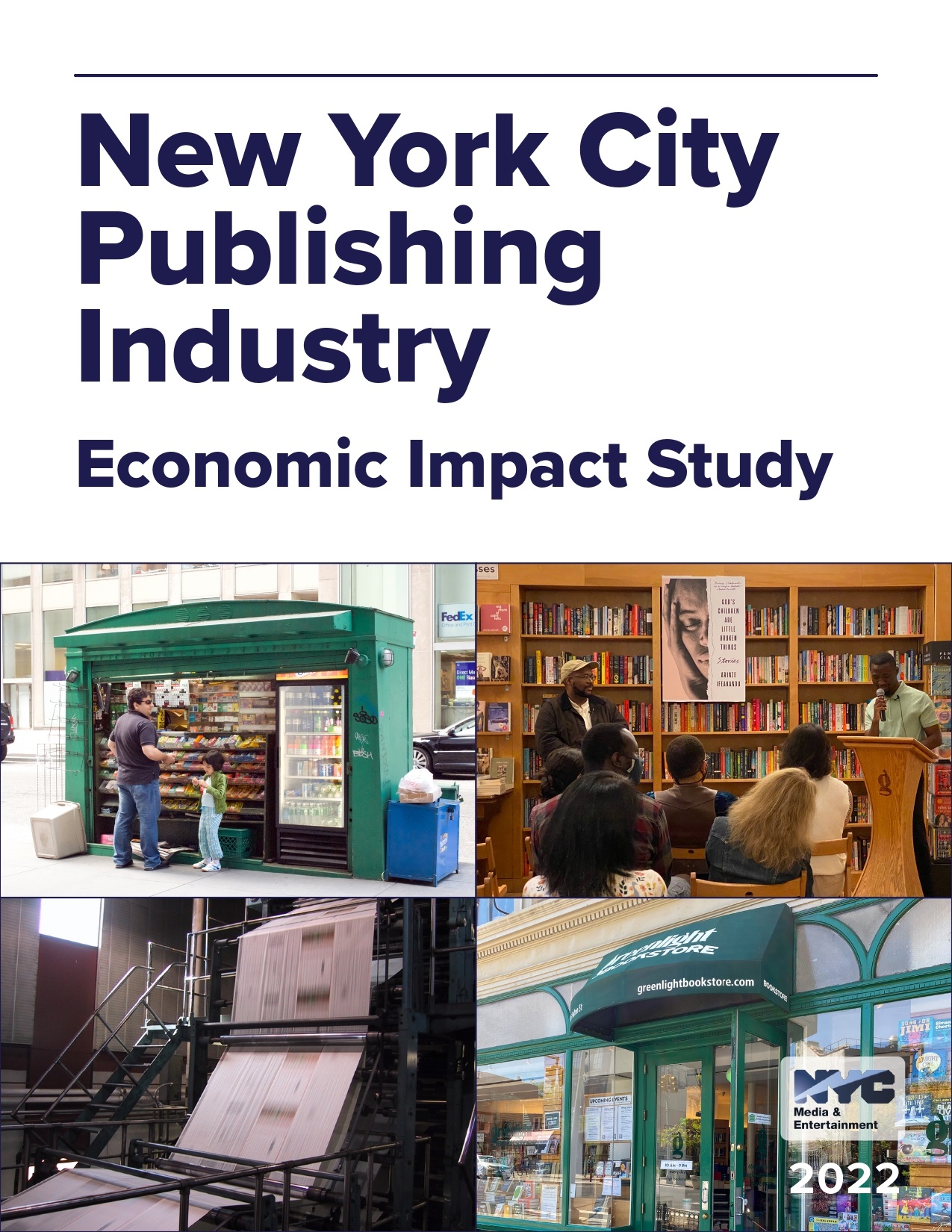
 Mayor's Office of Media and Entertainment311
Mayor's Office of Media and Entertainment311 Search all NYC.gov websites
Search all NYC.gov websites
Press Releases
The Mayor's Office of Media and Entertainment Conducts First-Ever Economic Analysis of NYC's Publishing Industry
Study Reveals Industry Generates $34 Billion in Total Economic Output
Outlines Recommendations and Current City-Led Initiatives that Address Inequities, Support Industry Growth and Recovery
NEW YORK, NY – The Mayor's Office of Media and Entertainment (MOME), whose portfolio of creative industries expanded to include NYC's historic publishing industry in 2016, today announced the results of the 2022 NYC Publishing Industry Economic Impact Study. The groundbreaking analysis details specifics on the industry's continued significance and contribution to New York City's creative economy. Most notably, in 2020 the industry supported a total of 95,000 jobs, $11 billion in wages, and $34 billion in economic output. The entire report is available here.
"As evidenced by this study, the publishing industry has long been a jewel in the crown of New York City's creative sector, and supporting this economic engine is a core strategy of this administration's agenda," said Deputy Mayor Maria Torres-Springer. "We look forward to continuing to work hand-in-hand with the publishing industry to ensure they continue to be future-focused, inclusive and supportive of local businesses and talent."
"We are proud to present the 2022 Publishing Industry Economic Impact Study, the first-of-its-kind comprehensive assessment of this industry's role in our city's economy, workforce and culture," said NYC Mayor's Office of Media and Entertainment Commissioner Anne del Castillo. "New York City has been and continues to be a global publishing center and literary hub, home to 'The Big 5' and the largest magazine and newspaper outlets, as well as a strong community of talent, independent booksellers, distributors and associations. This study will help inform our work in strengthening this sector as a vital contributor to the city's creative economy."
This study defines the publishing industry as composed of four sectors: Publishers, Talent (content creators), Print Production and Distribution & Consumption. Data from 2010-2020, which includes the full calendar year of 2020 and therefore reflects the impact of the COVID-19 pandemic, was evaluated to determine the total numbers. An additional assessment through June 2021 was used to more closely evaluate the pandemic's impact on the industry.
Highlights and recommendations from the study include:
Regarding Employment:
- Total industry employment declined between 2010 and 2020 by -2.8%, {p. 7} which may be attributed to the high cost of living locally, rapid digitization of media, growth of e-commerce, and pandemic decline in in-person events and book fairs. {p. 56}
- Talent sector employment increased by 4.8% and grew in total size by 60%, which speaks to NYC's continued resilience as a literary hub with strong networking opportunities, trade associations, and educational programs. {p. 23}
- Publishers sector (which includes print and digital media) represents 75% of the overall industry's direct employment and 81% of direct wages.
- Publishers sector employment declined across four U.S. benchmark cities, New York (-3.2%), San Francisco (-4.4%), Pittsburgh (-7.2%) and Boston (-7.4%), showing the decrease in the industry is nationwide. {p. 60}
- Internet Publishers, a subsector of the Publishers sector, employment increased at an average annual rate of 19% between 2010 and 2020, representing growth from approximately 300 to 1,700 employees, due to a demand for virtual content as computers, smartphones, and wireless infrastructure has become increasingly commonplace across the nation. {p. 30}
- Internet Publishers employment increase has not offset the annual average decrease of periodical (-5.9%) and newspaper (-2.1%) Publishers employment from 2010-2020, in part because the curation of online publications is more standardized than for print publications and requires fewer employees. {p. 8 & 30}
Regarding Equity & Diversity:
- Share of female employees in publishing industry is 51%, representing an increase of 3%-4% between 2010 and 2020, which is on par with the NYC average (52%) and indicative of the industry's utilization of NYC's strong pipeline of female talent. {p. 33}
- Share of non-white employees in publishing industry is 30%, much lower that the NYC average (53%), indicative of the industry's need to better improve efforts to recruit and retain from the city's diverse workforce. {p. 33}
Regarding Wages:
- All sectors experienced wage increases between 2010 and 2020 at average annual rate of 2.6%. {p. 24}
- Average annual wage of publishing industry workers is $122,000, above the city's overall average annual wage of $99,000. {p.24}
- Average annual wage encompasses a range of salaries from $30,000 (at newsprint mills) to $172,000 (at news syndicates). {p. 25}
Recommendations:
- Promote independent bookstores. MOME has launched the "Rediscover Your Local Bookstores" campaign, in collaboration with the NYC Department of Small Businesses (SBS), as part of NYC & Company's 'All in NYC' holiday shopping marketing campaign. A 2022 updated list of independent booksellers is now available, and the campaign is now live digitally and on billboards all over NYC.
- Support local media publishers. MOME partners with the Center for Community Media at the CUNY Craig Newmark Graduate School of Journalism to offer a sustainability training series and various workshops, meant to empower journalists and publishers in communities of color and immigrants, with a special focus on building digital skills.
- Support local talent. MOME provides access to free and discounted workspaces via the Freelancer's Hub, which officially opened at its new location in Industry City this year.
- Ensure equal access to education. MOME supports PEN America's DREAMing Out Loud tuition-free writing workshop for young immigrant writers, primarily those who are undocumented and/or DACA recipients, who came to the U.S. when they were children. Funding for the program has enabled it to establish new workshop sites at Lehman College in the Bronx, Medgar Evers College in Brooklyn, and Queens College.
- Facilitate connections among NYC publishing stakeholders. Explore partnerships with The Pulitzer Prize Board, National Book Awards and National Magazine Awards (Ellie Awards) to highlight and make connections between NYC's publishing businesses, artists, and smaller literary organizations.
- Promote NYC as a literary hub. Partner with New York State Council on the Arts (NYSCA) to promote and share the New York City literary map in public libraries, on public transit and in other public spaces.
- Promote NYC as a World Book Capital. Apply for NYC to be designated as the first UNESCO World Book Capital in the U.S., which would serve to increase access to books, promote freedom of speech and expression, and facilitate the expansion of public libraries.
NYC's publishing community has continued to redefine itself in the face of change, playing an important role in making NYC the creative capital of the world. Magazines, newspapers and books in print and digital formats have kept us informed and entertained during the city's darkest hours and most difficult moments, as most recently experienced during the COVID-19 pandemic. They also have served to inspire and unite New Yorkers in moments of reflection and celebration. This study comes as a pivotal moment as NYC recovers from the pandemic and looks for new, inclusive and innovative ways to support this thriving industry.
"As the former Commissioner of The Mayor's Office of Media and Entertainment, I'm proud to see that our city is supporting the publishing industry and expanding its efforts to keep it thriving. Our literary hubs bring billions of dollars in wages, thousands of jobs and the much-needed creativity that makes NYC the cultural center of the world. Releasing the results of the impact study and announcing new initiatives will ensure the publishing industry has continued success in our city's economy, culture and history," said Council Member Julie Menin.
“We should all be proud to see these strong numbers coming out of our publishing industry,” said New York City Council Member Chi Ossé, Chair of the Committee on Cultural Affairs. “The report also details areas in which the industry could improve, such as diversity metrics and wages at the lower end of the scale, and we are enthusiastic about MOME’s recommendations that we feel will alleviate some of these shortcomings while positioning publishing for strength and growth in the years ahead.”
"Established in 1985, Pace University's MS in Publishing program has long been a leader in Diversity, Equity and Inclusion initiatives with our motto Opportunitas. We offer an excellent publishing education that provides the necessary scholarships, internships, mentoring, and industry connections that assure future student success. This encouraging and well-researched report on the publishing industry confirms New York's central role in the publishing industry and identifies opportunities not only for growth but for city initiatives to support the industry on many levels, including education," said Manuela Soares, Director of Pace University's MS in Publishing program.
"While we have known intuitively that publishing is a significant driver of New York's vibrancy and prosperity, it's very powerful to see that impact measured and quantified. Thanks to MOME for their work shining a spotlight on the important role that publishing plays in our city and our region, and for their continued advocacy on behalf of the entire literary ecosystem," said Ruth Dickey, Executive Director, National Book Foundation.
ABOUT THE 2022 PUBLISHING INDUSTRY ECONOMIC IMPACT STUDY
The Mayor’s Office of Media and Entertainment (MOME) regularly conducts studies to build its understanding of NYC’s creative economy sectors and support their growth. MOME launched this study of the publishing industry in February 2022 as part of that effort. The study assesses the publishing industry’s core sectors – which span content generation to consumption for books, newspapers, and periodicals – in terms of their characteristics and economic impact. The study also offers recommendations for strategic policies, investments, and services that may contribute to the continued resilience of NYC’s publishing ecosystem.




